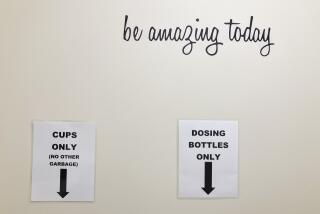Rethinking Approaches to Pain Relief
- Share via
SAN FRANCISCO — Our obsession with pain relief--a movement that gave rise to pain clinics, a cascade of new medications and even patient-controlled morphine pumps--is being replaced with a new medical mantra: Know your pain.
While doctors take seriously their obligation to relieve suffering, they are “rethinking” the role of pain and appropriate pain treatment.
This new restraint may mean consumers will receive fewer prescriptions for strong painkillers and more advice from doctors to go easy on over-the-counter pain medications, especially the more potent nonsteroidal anti-inflammatory drugs (NSAIDS) that millions of Americans take daily for arthritis and muscular pain.
“I’m sure there are very powerful and correct aspects to [Americans’ concern with pain relief], but the pendulum is beginning to swing back,” said Dr. James F. Fries, a Stanford University medical professor and expert in arthritis. Fries spoke at an American Medical Assn. forum for science writers here Sunday.
“It’s a question of what we’re doing to ourselves. Is there a dark side to taking these medications? And is there a sunny side to the experience of pain?”
The answer to both those questions is yes, Fries said.
For example, the overuse of NSAIDS, such as the family of medications containing ibuprofen, has recently led to an explosion in the number of bleeding ulcers, accounting for 10,000 to 20,000 deaths and 100,000 to 200,000 hospitalizations each year. Studies have revealed that about 25% of people who use NSAIDS for chronic pain relief develop ulcers.
Many of these individuals unwittingly create more problems by taking antacids to relieve the abdominal discomfort associated with the use of some pain medications. The antacids ease the stomach pain, but they “actually increase the risk of having a bleeding ulcer twofold. It’s this masking effect that, we believe, doubles the incidence of serious complications,” Fries said.
“We began to realize this was not a trivial problem. It’s the most common, serious side effect due to a preoccupation with pain relief.”
One response to the epidemic in bleeding ulcers is the development of newer NSAIDS with less toxicity. Another response is the emphasis on learning to tolerate pain in certain situations, Fries said.
For example, the new approach to treating lower back pain is to do nothing. The idea is that lower back pain is an injury similar to an ankle sprain and simply requires rest.
“Pain tells us not to use an injured part,” Fries said. “It helps you to prevent a re-injury. Sometimes we want to have a pain message around.”
Taking a pain medication for lower back pain may lead an individual to take on too much physical activity and re-injure the back, “resulting, downstream, with a greater amount of pain.”
Similarly, rheumatoid arthritis used to be treated with both pain medication and drugs to reduce the inflammation. Not anymore.
“Now, one focuses attention on reducing the inflammatory load using drugs that provide virtually no pain relief at all,” Fries said. These patients fare better in the long run.
“Think long term. Think outcome. Think lifetime pain--not necessarily making the patient feel better tomorrow,” he said. “Let’s make sure we use safe drugs and use the lowest doses possible. And let’s make sure it relieves pain.”
A surprising number of people are taking the riskier NSAIDS without even experiencing satisfying pain relief, he noted. The elderly, for instance, metabolize drugs less efficiently and will not benefit as much from some medications.
And many individuals would find that good old aspirin or acetaminophen works as well as ibuprofen compounds. Although many studies comparing aspirin with NSAIDS showed aspirin to be more toxic, those studies often compared extremely high aspirin doses with very low doses of NSAIDS. In reality, people tend to use lower doses of aspirin and higher doses of NSAIDS, he said.
Even exercise is a good antidote to pain, Fries said. Some research shows that long-distance runners develop a higher tolerance for pain.
“Good, regular exercise is one way to raise your confidence of being able to handle pain,” he said.
Consumers needn’t feel guilty about taking pain medication, he added, provided they are taking the least amount possible for relief.
“If you can’t identify a downside, and there is a significant upside, there is no reason not to use [medication],” he said. “But ask yourself, ‘Could I make things worse down the road?’ ”






